
The Black Sea is a marginal mediterranean sea of the Atlantic Ocean lying between Europe and Asia. It lies to the east of the Balkans in Southeast Europe, south of the East European Plain in Eastern Europe; and north of Anatolia and west of the Caucasus, both in Western Asia. The Black Sea is supplied by major rivers, principally the Danube, Dnieper, and Don. The waters of many countries drain into the sea beyond the six that share its coast.

The Mediterranean Sea is a sea connected to the Atlantic Ocean, surrounded by the Mediterranean Basin and almost completely enclosed by land: on the north by Western and Southern Europe and Anatolia, on the south by North Africa, and on the east by the Levant. The Sea has played a central role in the history of Western civilization. Although the Mediterranean is sometimes considered a part of the Atlantic Ocean, it is usually referred to as a separate body of water. Geological evidence indicates that around 5.9 million years ago, the Mediterranean was cut off from the Atlantic and was partly or completely desiccated over a period of some 600,000 years during the Messinian salinity crisis before being refilled by the Zanclean flood about 5.3 million years ago.

Limonium is a genus of 120 flowering plant species. Members are also known as sea-lavender, statice, caspia or marsh-rosemary. Despite their common names, species are not related to the lavenders or to rosemary. They are instead in Plumbaginaceae, the plumbago or leadwort family. The generic name is from the Latin līmōnion, used by Pliny for a wild plant and is ultimately derived from the Ancient Greek leimon.

Quercus coccifera, the kermes oak, is an oak bush in the Quercus section Cerris. It is native to the Mediterranean region and Northern African Maghreb, south to north from Morocco to France and west to east from Portugal to Cyprus and Turkey, crossing Spain, Italy, Libya, Balkans, and Greece, including Crete. The Kermes Oak was historically important as the food plant of the Kermes scale insect, from which a red dye called crimson was obtained. The etymology of the specific name coccifera is related to the production of red cochineal (crimson) dye and derived from Latin coccum which was from Greek κόκκος, the kermes insect. The Latin -fera means 'bearer'.

The Lessepsian migration is the migration of marine species across the Suez Canal, usually from the Red Sea to the Mediterranean Sea, and more rarely in the opposite direction. When the canal was completed in 1869, fish, crustaceans, mollusks, and other marine animals and plants were exposed to an artificial passage between the two naturally separate bodies of water, and cross-contamination was made possible between formerly isolated ecosystems. The phenomenon is still occurring today. It is named after Ferdinand de Lesseps, the French diplomat in charge of the canal's construction.
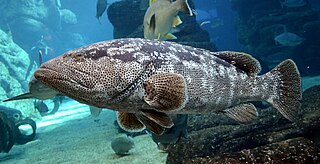
The Malabar grouper also known as blackspot rockcod, estuary rockcod, giant rock cod, greasy grouper, Malabar rockcod, Morgan's cod or speckled grouper, is a species of marine ray-finned fish, a grouper from the subfamily Epinephelinae which is part of the family Serranidae, which also includes the anthias and sea basses. It is found in the Indo-Pacific region. It has entered the Mediterranean Sea from the Red Sea by way of the Suez Canal as a Lessepsian migrant.

Palinurus elephas is a commonly caught species of spiny lobster from the East Atlantic Ocean and the Mediterranean Sea. Its common names include European spiny lobster, crayfish or cray, crawfish, common spiny lobster, Mediterranean lobster and red lobster.
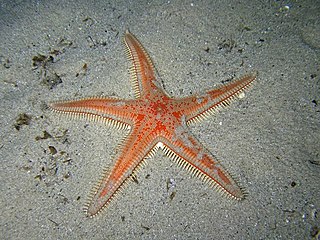
Astropecten aranciacus, the red comb star, is a sea star of the family Astropectinidae. It is native to the east Atlantic Ocean and Mediterranean Sea.
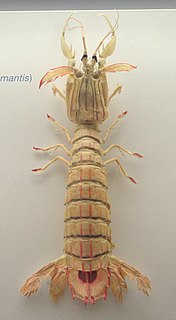
Squilla mantis is a species of mantis shrimp found in shallow coastal areas of the Mediterranean Sea and the Eastern Atlantic Ocean: it is also known as "pacchero" or "canocchia". Its abundance has led to it being the only commercially fished mantis shrimp in the Mediterranean.

Mactra stultorum, previously sometimes known as Mactra corallina, is a species of edible saltwater clam, a marine bivalve mollusc in the family Mactridae, the trough shells.
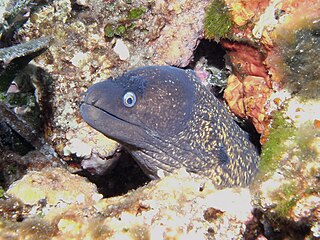
The Mediterranean moray is a fish of the moray eel family. It has a long eel-like body and is found in the eastern Atlantic Ocean and Mediterranean Sea. Its bite can be dangerous to humans.
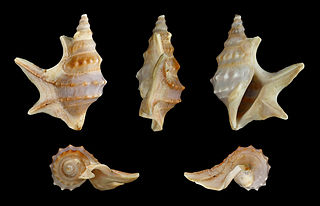
Aporrhais pespelecani, common name the "pelican's foot", is a species of sea snail, a marine gastropod mollusk in the family Aporrhaidae.

Scyllarus arctus is a species of slipper lobster which lives in the Mediterranean Sea and eastern Atlantic Ocean. It is uncommon in British and Irish waters, but a number of English-language vernacular names have been applied, including small European locust lobster, lesser slipper lobster and broad lobster.

Italy has one the highest level of faunal biodiversity in Europe, with over 57,000 species recorded, representing more than a third of all European fauna. This is due to various factors. The Italian peninsula is in the center of the Mediterranean Sea, forming a corridor between central Europe and North Africa, and it has 8,000 km of coastline. Italy also receives species from the Balkans, Eurasia, and the Middle East. Italy's varied geological structure, including the Alps and the Apennines, Central Italian woodlands, and Southern Italian Garigue and Maquis shrubland, also contribute to high climate and habitat diversity.

Patella ferruginea, commonly known as the ribbed Mediterranean limpet, is a species of sea snail, a true limpet, a marine gastropod mollusk in the family Patellidae, one of the families of true limpets. It is a large limpet, native to the western Mediterranean Sea, and although common in the past, it is now rare and restricted to only a few locations.
Tritia coralligena is a species of sea snail, a marine gastropod mollusk in the family Nassariidae, the Nassa mud snails or dog whelks.
Scyllarus pygmaeus is a species of slipper lobster that lives in shallow water in the Mediterranean Sea and eastern Atlantic Ocean. It grows to a length of 55 mm (2.2 in), which is too small for it to be fished for. The juvenile form was first described in 1885, with the description of the adult following in 1888 as a result of the Challenger expedition.
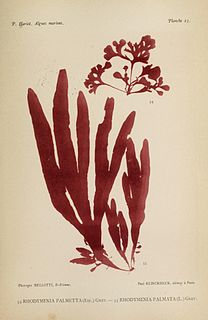
Rhodymenia is a genus of red algae, containing the following species:

The Levantine Sea is the easternmost part of the Mediterranean Sea.

The Mediterranean horse mackerel, also known as the Black Sea horse mackerel, horse mackerel, Mediterranean scad, common scad, or simply scad, is a species of mackerel in the family Carangidae found in the eastern Atlantic from Bay of Biscay to Mauritania, including the Mediterranean Sea. It is a benthopelagic, subtropical, marine fish that can reach up to 60 cm (24 in) in length. In the countries near the Mediterranean and Black Seas, it makes up a significant portion of fish catch, 54% of fish caught in the latter. Despite overfishing in the 1980s, catch numbers have leveled out and it is listed as least concern by the International Union for Conservation of Nature.

















